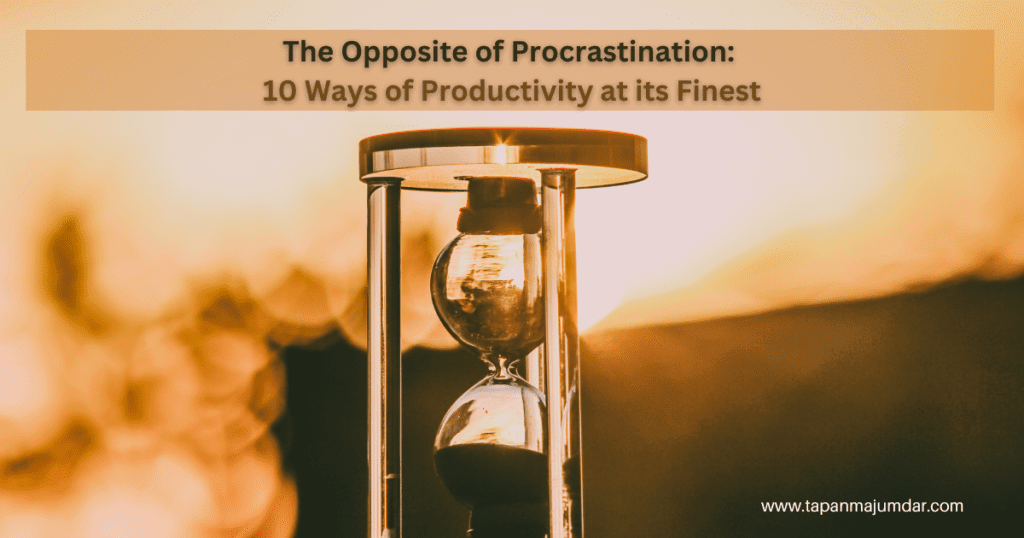The Opposite of Procrastination, Are you someone who always puts off tasks until the last minute, only to rush through them in a state of panic? Do you often feel overwhelmed by the amount of work you have to do, but somehow still manage to waste hours on social media and other distractions? If so, you’re not alone. Procrastination is a common problem that affects millions of people around the world. But what if there was a way to overcome it and become more productive than you ever thought possible?
In this article, we’ll explore the opposite of procrastination: productivity at its finest. We’ll delve into the strategies and habits that successful people use to stay focused, motivated, and on track. So if you’re ready to take your productivity to the next level, read on.
Introduction
In today’s fast-paced world, time is a precious commodity. With so much to do and so little time, it’s easy to feel overwhelmed and stressed out. That’s why productivity has become such a buzzword in recent years. Everyone from CEOs to stay-at-home parents is looking for ways to get more done in less time. But what exactly is productivity, and how can we achieve it?
Simply put, productivity is the ability to get things done efficiently and effectively. It’s about using your time and resources in the most optimal way possible to achieve your goals. And while some people seem to be born with a natural talent for productivity, it’s actually a skill that can be learned and developed over time.

The Opposite of Procrastination: Productivity at its Finest
Procrastination is the enemy of productivity. It’s the act of delaying or postponing tasks, even when we know that they’re important. Procrastination can take many forms, from mindlessly scrolling through social media to reorganizing your desk for the tenth time instead of starting on that report due tomorrow.
On the other hand, productivity is all about taking action. It’s about making progress towards your goals, no matter how small those steps may be. Productivity means setting priorities, breaking tasks into manageable chunks, and focusing your attention on what’s most important.
The opposite of procrastination is therefore productivity at its finest. It’s the ability to stay focused, motivated, and disciplined even when the going gets tough. It’s about having a clear sense of purpose and direction and taking consistent action towards your goals.
How to Be Productive: Strategies and Habits
Now that we’ve defined productivity and the opposite of procrastination, let’s dive into some strategies and habits that can help you become more productive in your daily life.
1. Set Clear Goals
One of the most important things you can do to know the opposite of procrastination and increase your productivity is to set clear goals. Without a clear sense of what you’re trying to accomplish, it’s easy to get distracted or feel overwhelmed. Make sure your goals are specific, measurable, and achievable. Write them down and keep them in a visible place so you can refer to them often. Here is a table illustrating how to set clear goals:
| Step | Description |
|---|---|
| 1. | Identify your long-term goals. |
| 2. | Break down your long-term goals into smaller, achievable goals. |
| 3. | Set specific, measurable, achievable, relevant, and time-bound (SMART) goals. |
| 4. | Write down your goals and review them regularly. |
| 5. | Make a plan to achieve your goals, including specific actions and deadlines. |
| 6. | Track your progress towards your goals and adjust your plan as necessary. |
Here’s a brief description of each step:
- Identify your long-term goals: Start by thinking about your overall vision for your life, career, or business. Identify what you want to achieve in the long term.
- Break down your long-term goals: Once you have identified your long-term goals, break them down into smaller, achievable goals. This will make them less daunting and easier to tackle.
- Set SMART goals: For each goal, make sure it is specific, measurable, achievable, relevant, and time-bound (SMART). This will help you stay focused and motivated.
- Write down your goals: Writing down your goals makes them more concrete and helps you remember them. Review your goals regularly to keep them top of mind.
- Make a plan: Once you have set your goals, make a plan to achieve them. This should include specific actions you need to take and deadlines for each action.
- Track your progress: Regularly track your progress towards your goals and adjust your plan as necessary. Celebrate your successes along the way to stay motivated.
By following these steps, you can set clear goals that will help you achieve your vision and improve your productivity.
2. Prioritize Your Tasks
Once you have clear goals, it’s time to prioritize your tasks. Start by identifying the most important tasks that will help you achieve your goals, and focus your attention on those first. This is known as the “80/20 rule” or the Pareto Principle, which states that 80% of your results come from 20% of your efforts. By focusing on the most important tasks, you can make the most of your time and achieve better results.

3. Break Tasks Into Manageable Chunks
Large tasks can often seem overwhelming, which can lead to procrastination. To avoid this, break larger tasks into smaller, more manageable chunks.

4. Use Time Management Techniques
Time management techniques can be incredibly helpful when it comes to boosting productivity. One popular technique is the Pomodoro Technique, which involves working on a task for 25 minutes and then taking a 5-minute break. Repeat this cycle four times, and then take a longer break. This technique helps to keep you focused and motivated and also ensures that you take regular breaks to avoid burnout.
| Time Management Techniques | Description |
|---|---|
| Make a to-do list | Write down all the tasks you need to complete |
| Prioritise your tasks | Rank your tasks by order of importance |
| Set deadlines | Give yourself a deadline for each task |
| Use the Pomodoro Technique | Work in 25-minute intervals, taking a 5-minute break between each interval |
| Use time-tracking apps | Track how much time you spend on each task to help you plan better |
| Avoid multitasking | Focus on one task at a time to minimise distractions |
| Block out time for deep work | Set aside specific times for focused, uninterrupted work |
| Delegate tasks | Assign tasks to others when possible to free up your own time |
| Learn to say no | Avoid taking on tasks that are not aligned with your goals or priorities |
5. Eliminate Distractions
Distractions are one of the biggest obstacles to productivity. To eliminate distractions, try turning off your phone, closing unnecessary tabs on your computer, and working in a quiet, distraction-free environment. If you’re easily distracted by social media, consider using an app like Freedom or Focus to block certain websites or apps during work hours.
6. Practice Self-Care
Taking care of yourself is an essential part of being productive. Make sure you’re getting enough sleep, eating well, and taking breaks throughout the day to recharge. Exercise can also be a great way to boost your energy levels and increase your productivity.
7. Learn to Say No
Saying yes to every request that comes your way can quickly lead to burnout and overwhelm. Learning to say no can be a powerful tool for boosting your productivity. Prioritize your own goals and commitments, and be selective about the projects and tasks you take on.
8. Build Habits and Routines
Habits and routines can be incredibly helpful when it comes to increasing productivity. By building a consistent schedule and sticking to it, you can reduce decision fatigue and ensure that you’re using your time effectively. Start by identifying the habits and routines that are most important to you, and then make a plan to implement them into your daily life. Here’s how to approach each step:
- Choose a cue: A cue is a trigger that prompts you to start a habit or routine. Choose a cue that is easy to recognise and associate with the habit you want to build. For example, if you want to build a habit of drinking more water, you could choose the cue of finishing a cup of coffee in the morning.
- Start small: Choose a small and manageable habit to start with. This will help you build momentum and make it easier to stick to the habit. For example, if you want to build a habit of exercising daily, start with just 10 minutes a day.
- Set a schedule: Decide when and where you will perform the habit or routine. This will help you establish a consistent habit and make it easier to stick to. For example, if you want to build a habit of meditating daily, decide to do it at the same time and in the same location every day.
- Be consistent: Consistency is key to building habits and routines. Stick to your schedule and perform the habit or routine every day, even if it’s just for a few minutes. This will help you establish the habit and make it a part of your daily routine.
9. Track Your Progress
Tracking your progress can be a great way to stay motivated and focused. Use a planner or a productivity app to track your tasks and goals, and celebrate your achievements along the way. Seeing your progress in black and white can be a powerful motivator to keep going.
10. Take Breaks
Taking breaks is essential for maintaining productivity over the long term. Make sure you’re taking regular breaks throughout the day to recharge your batteries and avoid burnout. Even a short walk or a few minutes of meditation can be enough to help you reset and refocus.
FAQs
Q: Is procrastination always bad?
A: Not necessarily. Procrastination can sometimes be a sign that you need a break or that you’re not passionate about a particular task. However, chronic procrastination can be a major obstacle to productivity and can lead to feelings of stress and overwhelm.
Q: Can productivity be learned?
A: Yes, productivity is a skill that can be learned and developed over time. By implementing strategies and habits like goal-setting, time management, and self-care, you can increase your productivity and achieve your goals more efficiently.
Q: How can I stay motivated when I’m feeling overwhelmed?
A: One of the best ways to stay motivated when you’re feeling overwhelmed is to break larger tasks into smaller, more manageable chunks. This can help you stay focused and make progress without feeling like you’re taking on too much at once. It’s also important to take breaks and practice self-care to avoid burnout.
Q: What is the best time management technique?
A: The best time management technique is the one that works best for you. Some people find the Pomodoro Technique helpful, while others prefer to work in longer blocks of time. Experiment with different techniques until you find the one that works best for you.
Q: How can I eliminate distractions when working from home?
A: To eliminate distractions when working from home, try creating a dedicated workspace that is free from distractions. Turn off your phone, close unnecessary tabs on your computer, and use headphones to block out noise. You can also try using apps like Freedom or Focus to block distracting websites or apps during work hours.
Q: How important is self-care for productivity?
A: Self-care is essential for productivity. Taking care of yourself by getting enough sleep, eating well, and taking breaks throughout the day can help you stay focused and energized. Exercise can also be a great way to boost your energy levels and increase your productivity.
Conclusion
The opposite of procrastination is productivity at its finest. By implementing strategies like goal-setting, time management, and self-care, you can increase your productivity and achieve your goals more efficiently. Remember to take breaks, eliminate distractions, and learn to say no when necessary. Build habits and routines that work for you, and track your progress along the way. With these strategies, you can overcome procrastination and achieve your goals with ease.
So, start implementing these strategies today and see the difference in your productivity. Remember, small steps can lead to big results. It’s never too late to start being productive and achieving your goals. The opposite of procrastination is productivity at its finest, and it’s up to you to make it happen.
Thank you for reading this article on The Opposite of Procrastination: Productivity at its Finest. We hope you found it helpful and informative. If you have any questions or comments, please feel free to reach out to us.


